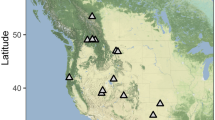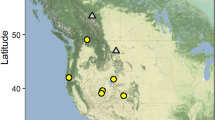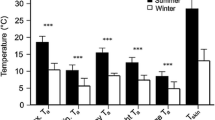Abstract
Most studies of hibernation physiology sample individuals from populations within a single geographic area, yet some species have large ranges meaning populations likely experience area-specific levels of energetic challenges. As well, few studies have assessed within-season variation. Since physiological adjustments often are influenced by environmental factors, and the types of environments vary with geography, we expected variance in hibernation patterns among geographically separated populations. Our specific goal was to measure intraspecific variation in torpid metabolic rate (TMR) and body temperature (T b) as a function of ambient temperature (T a) for a non-migratory and migratory species to determine whether there is a continuum in physiological responses based on latitude. We chose big brown (Eptesicus fuscus) and eastern red bats (Lasiurus borealis) as model species and sampled individuals from populations throughout each species’ winter range. In both species, individuals from southern populations maintained higher TMR at cooler T as and lower TMR at warmer T as than those from northern populations. Big brown bats from southern populations regulated T b during torpor at higher levels and there was no significant difference in T b between populations of eastern red bats. Although metabolic responses were similar across the gradient between species, the effect was more dramatic in big brown bats. Our data demonstrate a continuum in thermoregulatory response, ranging from classic hibernation in northern populations to a pattern more akin to daily torpor in southern populations. Our research highlights the potential usefulness of bats as model organisms to address questions about within-species physiological variation in wild populations.





Similar content being viewed by others
References
American Society of Mammalogists Animal Care and Use Committee (1998) Guidelines for the capture, handling, and care of mammals as approved by the American Society of Mammalogists. J Mammal 79:1416–1431
Arlettaz R, Ruchet C, Aeschimann J, Burn E (2000) Physiological traits affecting the distribution and wintering strategy of the bat Tadarida teniotis. Ecology 81:1004–1014
Aschoff J (1981) Thermal conductance in mammals and birds: its dependence on body size and circadian phase. Comp Biochem Physiol 69:611–619
Audet D, Thomas DWT (1996) Evaluation of the accuracy of body temperature measurement using external radio transmitters. Can J Zool 74:1778–1781
Barclay RMR, Kalcounis MC, Crampton LH, Stefan C, Vonhof MJ, Wilkinson L, Brigham RM (1996) Can external radiotransmittors be used to assess body temperature and torpor in bats? J Mammal 77:1102–1106
Boyles JG, Timpone JC, Robbins LW (2003) Late winter observations of red bats, Lasiurus borealis, and evening bats, Nycticeius humeralis, in Missouri. Bat Res News 44:59–61
Boyles JG, Dunbar MB, Whitaker JO Jr (2006) Activity following arousal in winter in North American vespertilionid bats. Mammal Rev 36:267–280
Boyles JG, Dunbar MB, Storm JJ, Brack V Jr (2007) Energy availability influences microclimate selection of hibernating bats. J Exp Biol 210:4345–4350
Bozinovic F, Muñoz JLP, Naya DE, Cruz-Neto AP (2007) Adjusting energy expenditures to energy supply: food availability regulates torpor use and organ size in the Chilean mouse-opossum Thylamys elegans. J Comp Physiol B 177:393–400
Brigham RM (1987) The significance of winter activity by the big brown bat (Eptesicus fuscus): the influence of energy reserves. Can J Zool 65:1240–1242
Coburn DK, Geiser F (1998) Seasonal changes in energetics and torpor patterns in the subtropical blossom-bat Syconycteris australis (Megachiroptera). Oecologia 113:467–473
Cryan PM (2003) Seasonal distribution of migratory tree bats (Lasiurus and Lasionycteris) in North America. J Mammal 84:579–593
Dunbar MB, Tomasi TE (2006) Arousal patterns, metabolism, and a winter energy budget of eastern red bats (Lasiurus borealis). J Mammal 87:1096–1102
Gannon WL, Sikes RS, and the Animal Care, Use Committee of the American Society of Mammalogists (2007) Guidelines of the American Society of Mammalogists for the use of wild mammals in research. J Mammal 88:809–823
Garland T Jr, Adolph SC (1991) Physiological differentiation of vertebrate populations. Annu Rev Ecol Syst 22:193–228
Geiser F (1988) Reduction of metabolism during hibernation and daily torpor in mammals and birds: temperature effect or physiological inhibition? J Comp Physiol B 158:25–38
Geiser F (2007) Yearlong hibernation in a marsupial mammal. Naturwiss 94:941–944
Geiser F, Baudinette RV (1987) Seasonality of torpor and thermoregulation in three dasyurid marsupials. J Comp Physiol B 157:335–344
Geiser F, Ferguson C (2001) Intraspecific differences in behaviour and physiology: effects of captive breeding on patterns of torpor in feathertail gliders. J Comp Physiol B 171:569–576
Geiser F, Kenagy GJ (1988) Torpor duration in relation to temperature and metabolism in hibernating ground squirrels. Physiol Zool 61:442–449
Geiser F, Ruf T (1995) Hibernation versus daily torpor in mammals and birds: physiological variables and classification of torpor patterns. Physiol Zool 68:935–966
Geiser F, Holloway JC, Körtner G, Maddocks TA, Turbill C, Brigham RM (2000) Do patterns of torpor differ between free-ranging and captive mammals and birds? In: Heldmaier G, Klingenspor M (eds) Life in the cold. Springer, Germany, pp 95–102
Humphries MM, Thomas DW, Speakman JR (2002) Climate-mediated energetic constraints on the distribution of hibernating mammals. Nature 418:313–316
Humphries MM, Thomas DW, Kramer DL (2003a) The role of energy availability in mammalian hibernation: a cost-benefit approach. Physiol Biochem Zool 76:165–179
Humphries MM, Thomas DW, Kramer DL (2003b) The role of energy availability in mammalian hibernation: an experimental test in free-ranging eastern chipmunks. Physiol Biochem Zool 76:180–186
Humphries MM, Umbanhowar J, McCann KS (2004) Bioenergetic prediction of climate change impacts on Northern mammals. Integr Comp Biol 44:152–162
King WJ, Festa-Bianchet M, Hatfield SE (1991) Determinants of reproductive success in female Columbian ground squirrels. Oecologia 86:528–534
Kurta A, Baker RH (1990) Eptesicus fuscus. Mammalian Species 356:1–10
Liknes ET, Scott SM, Swanson DL (2002) Seasonal acclimatization in the American goldfinch revisited: to what extent do metabolic rates vary seasonally? Condor 104:548–557
Lyman CP (1948) The oxygen consumption and temperature regulation of hibernating hamsters. J Exp Biol 109:55–78
Mager KJ, Nelson TA (2001) Roost-site selection by eastern red bats (Lasiurus borealis). Am Midl Nat 145:120–126
Milam-Dunbar MB (2005) Ecophysiology of hibernating eastern red bats (Lasiurus borealis). Dissertation, Missouri State University
Mills RS, Barrett GW, Farrell MP (1975) Populations dynamics of the big brown bat (Eptesicus fuscus) in southwestern Ohio. J Mammal 56:591–604
Moorman CE, Russel KR, Menzel MA, Lohr SM (1999) Bats roosting in deciduous leaf litter. Bat Res News 40:74–75
Mormann BM, Robbins LW (2007) Winter roosting ecology of eastern red bats in Southwest Missouri. J Wildlife Manage 71:213–217
Mueller P, Diamond J (2007) Metabolic rate and environmental productivity: well-provisioned animals evolved to run and idle fast. Proc Natl Acad Sci USA 98:12550–12554
Neuweiler G (2000) Reproduction and development. In: The biology of bats. Oxford University Press, Oxford, pp 236–261
Parmesan C, Yohe G (2003) A globally coherent fingerprint of climate change impacts across natural systems. Nature 421:37–42
Pörtner HO, Bennett AF, Bozinovic F, Clarke A, Lardies MA, Lucassen M, Pelster B, Schiemer F, Stillman JH (2006) Trade-offs in thermal adaptation: the need for a molecular to ecological integration. Physiol Biochem Zool 79:296–313
Racey PA, Entwistle AC (2000) Life-history and reproductive strategies of bats. In: Crichton EG, Krutzsch PH (eds) Reproductive biology of bats. Academic Press, London, pp 363–414
Rainey WE, Pierson ED, Colberg M, Barclay JH (1992) Bats in hollow redwoods: seasonal use and role in nutrient transfer into old growth communities. Bat Res News 33:71
Ransome RD (1971) The effect of ambient temperature on the arousal frequency of the hibernating greater horseshoe bat, Rhinolophus ferrumequinum, in relation to site selection and the hibernation site. J Zool 164:353–371
Reite OB, Davis WH (1966) Thermoregulation in bats exposed to low ambient temperatures. Proc Soc Exp Biol Med 121:1212–1215
Rodrigue JL, Schuler TM, Menzel MA (2001) Observations of bat activity during prescribed burning in West Virginia. Bat Res News 42:48–49
Saugey DA, Vaughn RL, Crump BG, Heidt GA (1998) Notes on the natural history of Lasiurus borealis in Arkansas. J Arkansas Acad Sci 52:92–98
Schleucher E, Withers PC (2001) Re-evaluation of the allometry of wet thermal conductance for birds. Comp Biochem Physiol 129:821–827
Schmidt-Nielsen K (1990) Temperature regulation. In: Animal physiology, 4th edn. Cambridge University Press, New York, pp 240–295
Scholander PF, Hock R, Irving LV (1950) Adaptation to cold in artic and tropical mammals and birds in relation to body temperature, insulation and basal metabolic rate. Biol Bull 99:259–271
Shump KA, Shump AU (1982) Lasiurus borealis. Mammalian Species 183:1–6
Soriano PJ, Ruiz A, Arends A (2002) Physiological responses to ambient temperature manipulation by three species of bats from Andean Cloud forests. J Mammal 83:445–457
Thomas DW, Dorais M, Bergeron JM (1990) Winter energy budgets and cost of arousals for hibernating little brown bats, Myotis lucifugus. J Mammal 71:475–479
Twente JW (1955) Some aspects of habitat selection and other behavior of cavern dwelling bats. Ecology 36:706–732
Vernberg FJ (1962) Comparative physiology: latitudinal effects on physiological properties of animal populations. Ann Rev Physiol 24:517–544
Vernberg FJ, Tashian RE (1959) Studies on the physiological variation between tropical and temperature zone fiddler crabs of the genus Uca I. Thermal death limits. Ecology 40:589–593
Wang LCH (1978) Energetic and field aspects of mammalian torpor: the Richardson’s ground squirrel. In: Wimsatt WA (ed) Strategies in cold. Academic Press, New York, pp 109–145
Whitaker JO Jr, Gummer SL (2000) Population structure and dynamics of big brown bats (Eptesicus fuscus) hibernating in buildings. Am Midl Nat 143:389–396
Willis CKR, Brigham RM (2003) Defining torpor in free-ranging bats: experimental evaluation of external temperature-sensitive radio transmitters and the concept of active temperature. J Comp Physiol B 173:379–389
Willis CKR, Lane JE, Liknes ET, Swanson DL, Brigham RM (2005) Thermal energetics of female big brown bats (Eptesicus fuscus). Can J Zool 83:871–879
Withers PC (2001) Design, calibration and calculation for flow-through respirometry systems. Aust J Zool 49:445–461
Acknowledgments
Financial support was provided by the University of Regina Faculty of Graduate Studies and NSERC (20021-2555-300). We thank J. Boyles, J. Gruver, B. Scullon, T. Tomasi, S. Gardner, S. Samoray, J. Martin (and family), S. Allydog, T. Maddox, D. Aubrey, S. Lund, P. Neary, R. Treble, H. Broders and H. Weger for their comments on earlier drafts, help with analysis and assistance in the field and/or lab. Indiana State University, Missouri State University Bull Shoals Field Station, and the Solon Dixon Forestry Education Center (and staff) provided housing and/or lab space during field work. We also thank the two anonymous reviewers whose comments helped to strengthen our manuscript.
Author information
Authors and Affiliations
Corresponding author
Additional information
Communicated by I. D. Hume.
Rights and permissions
About this article
Cite this article
Dunbar, M.B., Brigham, R.M. Thermoregulatory variation among populations of bats along a latitudinal gradient. J Comp Physiol B 180, 885–893 (2010). https://doi.org/10.1007/s00360-010-0457-y
Received:
Revised:
Accepted:
Published:
Issue Date:
DOI: https://doi.org/10.1007/s00360-010-0457-y




